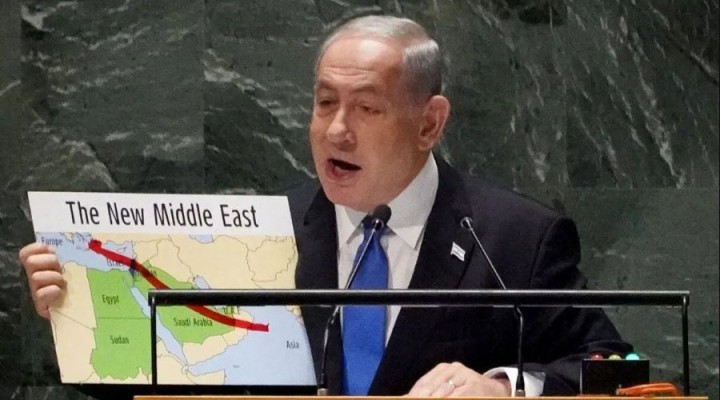The UN’s acquiescence to erasing Palestine

Erasing Palestine is what the Zionist colonial project is about. At the United Nations General Assembly (UNGA), Israeli Prime Minister Benjamin Netanyahu illustrated the aim by showing a map of Greater Israel – completely eliminating the existence of Gaza and the occupied West Bank – the only remaining fragments of Palestinian land. “The Abraham Accords heralded the dawn of a new age of peace,” Netanyahu said in his address to the UNGA.
While peace is far from what Netanyahu wishes to achieve, the Abraham Accords have indeed contributed to a new era of politics, which the UN and the Palestinian Authority (PA) refuse to address. Both fixate on the two-state paradigm, though Israel is several steps ahead following a trajectory the UN is not averse to, and the PA will ultimately capitulate to, given that it lacks any semblance of political direction.
Questioned by journalists during a press conference, the UN’s Spokesperson Stephane Dujarric distanced the international organisation from Netanyahu’s new map of the Middle East and deflected criticism by stating: “The UN will continue to advocate for a two-state solution to the Israeli-Palestinian conflict.” Netanyahu’s actions, Dujarric stated: “Did not change the UN’s stance.”
Maybe the UN’s stance has not changed, at least rhetorically. However, the UN’s complicity in creating Israel cannot be overlooked. The UN knew it was legitimising a colonial presence in Palestine and that the 1947 Partition Plan, which laid the foundations for the two-state paradigm, would ultimately aid Israel’s expansion plans. Talking about a stance is the weakest possible excuse the UN could come up with when it knows its stance did not prevent Israel from pursuing different forms of ethnic cleansing to eliminate Palestine and Palestinians.
“We can’t control nor do we wish to control what member states say or what they display at the podium,” Dujarric explained. However, what Netanyahu displayed at the UNGA is a reflection of what is possibly forthcoming as a result of the Abraham Accords and the defunct two-state compromise, for which the UN is still advocating.
Dujarric might prefer not to connect Netanyahu’s map display to the politics that are creating new political trajectories in the Middle East, reflecting the UN’s conduct throughout the decades and how it establishes parallel realities to sustain its diplomacy. From the 1947 Partition Plan, the International Day of Solidarity with the Palestinian People emerged, which does not even focus on the UN’s culpability in aiding the Zionist colonisation process in Palestine.
When Israel attacks Gaza and the occupied West Bank, the UN is quick to rush to Israel’s security narrative. With the Abraham Accords, the UN found no objection to normalising relations with Israel even though the diplomatic path places Palestinians at a greater disadvantage and at the risk of elimination, as Netanyahu envisages.
One question for Dujarric, however: If the UN does not wish to control what is expressed in its halls, how much more reluctant is it to challenge actions on the ground that clearly violate international law, as Israel’s existence and its violence are?
https://www.middleeastmonitor.com/20230930-the-uns-acquiescence-to-erasing-palestine/
 TheAltWorld
TheAltWorld 
0 thoughts on “The UN’s acquiescence to erasing Palestine”